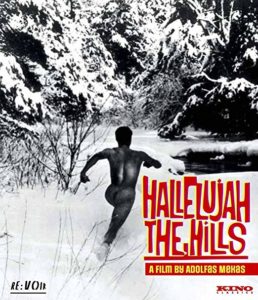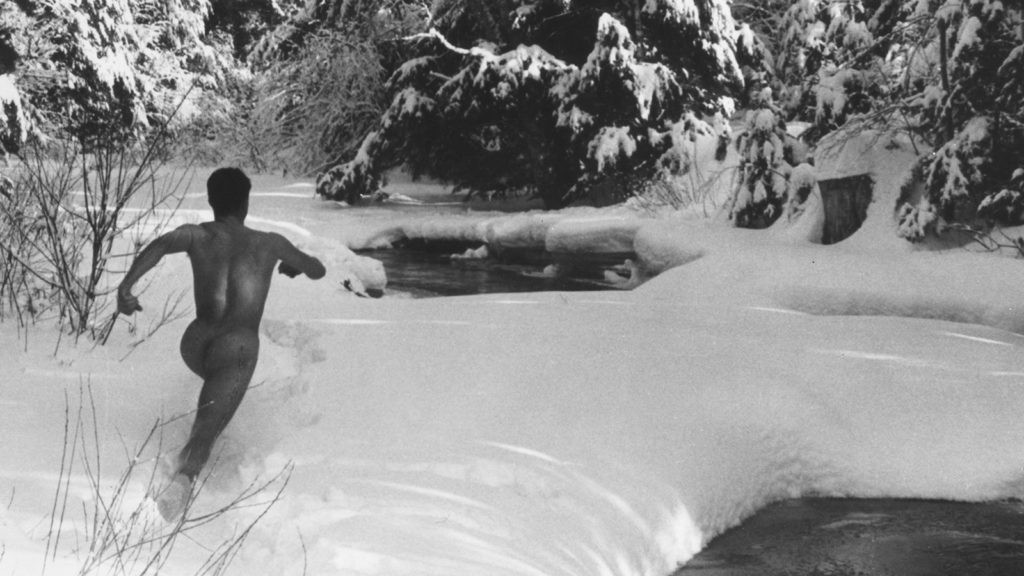A Hidden Classic of Comedic Absurdity
DIRECTED BY ADOLFAS MEKAS/1963
BLU-RAY STREET DATE: OCTOBER 30, 2018/KINO CLASSICS

Does one get to say that a film one has just discovered is one of the greatest comedies of all time if one finds it nearly impossible to describe what said film is about? Welcome to the Hills of the late filmmaker Adolfas Mekas. Mekas, an American transplant who was into Dadaism, improvisation, and all-around absurdity, channeled all of that and more into his first and by-far most famous film, 1963’s still-obscure Hallelujah the Hills. Above all, though, it’s clear that that Mekas, in all his obvious wit and flair, was a cinephile. Only a devoted hand-over-fist cinephile would make this movie. That, or a brilliant loon. (Hmmm…)
Kino Classics Blu-ray edition is a true gift to fans of spirited comedy, obscure cinema, and unhinged creativity.
Bounding outward in cheap black and white, a poppy soundtrack, and more than a few abrupt jump cuts that may or may not be intentional, Hallelujah the Hills is positively anarchic to its very core. Appearing on the zesty, rules-shattering heels of the French New Wave, this, Mekas’s own masterpiece, is a freeform blend of sensibilities, copping everything from Godard’s Breathless to the Marx Brothers, with liberal doses of slapstick silent comedy and even borrowed (homaged?) footage. It’s the kind of thing that must’ve inspired Richard Lester and the Beatles in their making of A Hard Day’s Night, at least indirectly if not directly. Perhaps it was unindirectly. Attempts at intellectual dot connecting and reading of “symbolism” will only prove futile; this is true “anything goes” cinema.

In David Avallone’s 2009 short Hallelujah the Villa, a twenty-six minute supplemental interview video/lark, a much older Mekas has a ridiculous blast giving wacky answers to silly questions about the Hills. The mountainside villa in which they’re shooting? “Paid for with my money from Hallelujah the Hills.”, he boasts as they have a seat in on white plastic patio furniture, the kind not uncommon to Walgreens. Regarding his initial inspiration, he claims, in a ringing reverb-enhanced voice, that out of the blue, God instructed his younger self, “Go forth and make a movie with two shlubs and a beautiful woman!” To which he says he replied, “What…? That’s it?!?” But, despite a later admission of being an atheist, he made Hallelujah the Hills. And hallelujah, here we are.
If one must assign meaning or even theme to this (which this one generally must, this being a review and all), the go-to read, in this writer’s opinion, has to do with male heartbreak. As film critic Christy Lemire once said about another scrappy, obscure, hard-to-peg indie, 2011’s Bellflower, “It’s about how male heartbreak feels like the apocalypse.” Our two shlubs in question, Jack (a handsome and hyper-committed Peter H. Beard) and Leo (a wryer clown, bespectacled and taller) are well dressed men of few words in a movie of even fewer.
Inseparable in both situation and in actuality, their shared love of the same girl, Vera (played by two separate actresses, Sheila Finn is “Jack’s Vera” and Peggy Steffans is “Leo’s Vera”) share a bond of young male rejection and sorrow. This leads them to take up alone together in a hunting cabin in the woods. Seasons give way to other seasons as these guys’ antics continue unabated and with the bare minimum of explanation. (What explanation we do get is provided mostly via silent movie title cards). Early on, Vera’s father informs the pair that his daughter has forsaken both of them, having married some wormy stooge called Gideon (Ed Emshwiller). Unrelenting polka music chaotically scores their subsequent fake warfare, perilous tree excursions, and extended flashbacks highlighing their better times with Vera.

The actors give it their unmitigated all, slipping and sliding and flipping and flopping all throughout this movie. Peter Beard in particular performs his way through the movie as though it’s a competition that he wants to make sure he wins. It appears that there’s nothing he won’t do, no dare too extreme to deny. He climbs ridiculously tall trees, he pratfalls, he tears around the frigid snowcapped desolation of rural Vermont in the buff (his bare butt providing the film’s only “objectionable content”. Naturally, it’s the case art for the Blu-ray). It’s true we know no detailed backstories of any of these people, except for the cagey kookiness the narrative randomly doles out. And that’s fine. Physicality reigns supreme with this nutty movie. Running, jumping and standing still, the performers (several of whom list this as their only film performance) grasps Mekas’ merry, mirthful mechanizations in full.
Kino Classics Blu-ray edition is a true gift to fans of spirited comedy, obscure cinema, and unhinged creativity. Besides the SD carryover Hallelujah the Villa, this disc also gives us a short vintage TV interview from a studio interview show called Camera Three. Mekas and another director are chatted up regarding their films’ having taken the first New York Film Festival by storm. It’s the kind of dry, white interview where everyone sits in suits with cigarettes, being all sophisticated and astute. Mekas looks positively squirmy here, but he manages nicely.
Kino’s transfer of Hallelujah the Hills displays a milky, no-frills greyscale authenticity about it, one that quite likely is the finest home video representation of the original theatrical experience; and likely by a very wide margin. When Jack gets his nose twisted by a pliers on close-up, you can really see the indentations. As stated earlier, the look of this cobbled-together production couldn’t have ever been stellar. But, Mekas landed on an aesthetic that compliments what he’s doing.

There is an attractive printed booklet with pictures and and essay by John Pruitt; a good read even if it can’t help but veer down that path of ascribing interpretation. As far as such attempts go, it’s a fine one- even as he himself knows better. Early in the essay, he quotes Mark Twain’s “disclaimer” at the beginning of Huckleberry Finn:N
NOTICE: Persons attempting to find a motive in this narrative will be prosecuted; persons attempting to find a moral in it will be banished; persons attempting to find a plot in it will be shot.
Ah, John Pruitt, we hardly knew ye. Another such blurb, one by Jean-Luc Godard, has been recently bandied in the online marketing for a new Blu-ray of his film, Sympathy for the Devil: “…There is only one way to be an intellectual revolutionary, and that is to give up being an intellectual.”
This from a critic-turned-essential-filmmaker known for his blunt intellectual acumen. Perhaps that assessment is as inaccurate as anything about Godard, though if he’s actually not thinking himself in circles, he’s leading us to do so. So then, less dizzy than all that, it’s fitting that his brief 1963 Cahiers du cinéma review of Hallelujah the Hills is included on the last page of the booklet. Sure enough, he’s a fan: “Shot according to the good, old principle of one idea per shot, his Hills is scented with fresh ingenuity and crafty sweetness. Physical effort and intellectual gags rub shoulders here.”
Hallelujah, now that’s a review. Therefor, it’s time for this one to abruptly end, and for all of us to head for the Hills.
The images in this review are not representative of the actual Blu-ray’s image quality, and are included only to represent the film itself.

